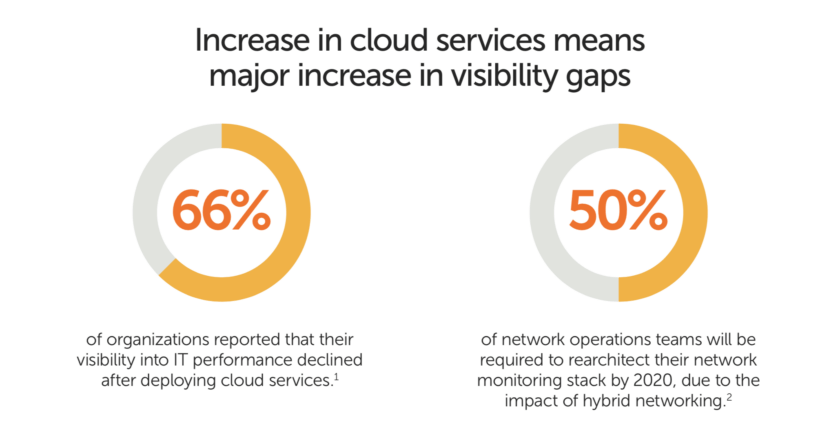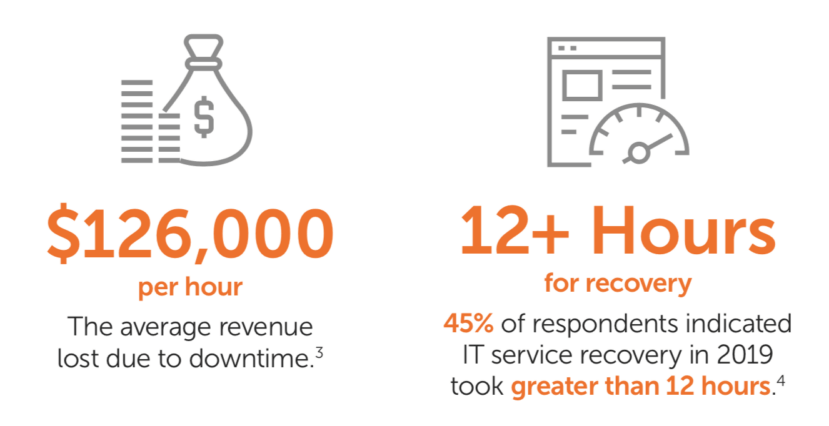While the benefits of cloud infrastructure and applications continue to drive enterprises to direct more of their IT investments in that direction, the cloud is certainly not a panacea—especially when it comes to maintaining visibility across an increasingly hybrid IT landscape.
Consider the experience of Jamie Halcomb, CIO of the U.S. Patent and Trademark Office. In a WSJ article (Dec 31, 2019) CIOs Share Their Priorities for 2020, Halcomb shares: “Part of my mission is to stabilize mission-critical systems and take our agile and DevSecOps practices to the next level while we move assets into the cloud.”
Halcomb seeks to increase agility while maintaining stability. But distributing applications across on-prem data center, cloud and SaaS adds new complexity. This fundamentally makes it harder to ensure the availability and performance of these apps. One reason for this is that blind spots increase as the IT landscape becomes more hybrid and complex.
And so, while digital transformation has made technology a critical part of an organization’s success, increasing service disruptions can have a profound impact on user experience, brand value and financials of a company.

In order to maintain a high-performing, reliable and secure network, you need a broad and complete view across IT domains—on-premises and in the cloud.
Achieving a holistic view of your critical hybrid IT environment requires the integration of multiple approaches. There are two primary approaches to help you ensure availability and measure end-user experience:
- Real-time user monitoring (RUM)
- Synthetic testing/monitoring
What is real-time user monitoring?
Real-time user monitoring (RUM) measures one of the most critical metrics: actual user experience as, and when, they interact with their apps. RUM constantly observes the system in the background—tracking availability, functionality, responsiveness and other metrics. This approach leverages real user traffic to gauge performance.
What is synthetic testing / synthetic monitoring?
Synthetic monitoring and testing is a method used to monitor your applications or infrastructure running in the cloud or on-premises data center by simulating users. It is an active testing method and very useful for measuring availability and response time of critical web sites, system transactions and applications. It works whether you have user traffic or not.
How does synthetic monitoring/testing work?
Synthetic monitoring, or synthetic testing, uses distributed test engines to proactively evaluate the availability and performance of your applications and web properties—even when there is no real user traffic. With synthetic monitoring, scripts or agents are deployed across the globe at key user locations to simulate the path an end user takes when accessing on-prem or cloud applications. The applications can reside anywhere—in the data center, in the IaaS cloud or a SaaS application. As long as there is a path to the application from the testing location, synthetic testing can be used.
Benefits of synthetic monitoring for hybrid applications
- Proactively identify issues before your users notice
- Keep a pulse on availability and performance round the clock
- Take monitoring where your applications go
- Monitor complex interactions live or pre-release
- Baseline and objectively measure application SLAs
Riverbed’s solution
Riverbed Unified NPM provides both synthetic and real-time user monitoring giving you a complete view of performance from the end-user perspective. Riverbed’s synthetic testing can simulate searching (database), adding items to cart (web application), logging in (identity validation), etc. in order to measure the performance of holistic application interactions. Riverbed NetIM, part of the NPM suite, offers a variety of synthetic tests, including Ping, DNS, TCP, LDAP, databases, HTTP, and external scripts for creating your own tests. It uses SNMP, CLI, Traps, Syslogs and API polling as well as synthetic testing to capture availability and performance information of network devices, servers and applications.
Are you using synthetic monitoring in your environment? How are you using it? Share your experiences in the comments below.
- Digital Enterprise Journal “19 key areas shaping IT performance markets in 2020” — Apr 22, 2020
- Market Guide for Network Performance Monitoring and Diagnostics. Published 5 March 2020 — ID G00463582
- Digital Enterprise Journal, March 2020
- Annual outage analysis 2020 — Uptime Institute (March 2020)
